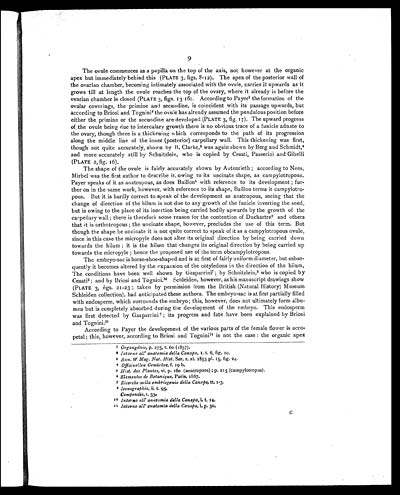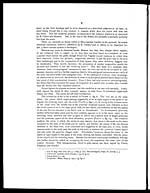Medicine - Institutions > Army health reports and medical documents > Scientific memoirs by officers of the Medical and Sanitary Departments of the Government of India > Number 12 - On the morphology, teratology, and diclinism of the flowers of cannabis > On the morphology, teratology, and diclinism of the flowers of cannabis
(15) Page 9
Download files
Individual page:
Thumbnail gallery: Grid view | List view

9
The ovule commences as a papilla on the top of the axis, not however at the organic
apex but immediately behind this (PLATE 3, figs. 8-12). The apex of the posterior wall of
the ovarian chamber, becoming intimately associated with the ovule, carries it upwards as it
grows till at length the ovule reaches the top of the ovary, where it already is before the
ovarian chamber is closed (PLATE 3, figs. 13.16). According to Payer1 the formation of the
ovular coverings, the primine and secundine, is coincident with its passage upwards, but
according to Briosi and Tognini2 the ovule has already assumed the pendulous position before
either the primine or the secundine are developed (PLATE 3, fig. 17). The upward progress
of, the ovule being due to intercalary growth there is no obvious trace of a funicle adnate to
the ovary, though there is a thickening which corresponds to the path of its progression
along the middle line of the inner (posterior) carpellary wall. This thickening was first,
though not quite accurately, shown by B. Clarke,3 was again shown by Berg and Schmidt,4
and more accurately still by Schnitzlein, who is copied by Cesati, Passerini and Gibelli
(PLATE 2, fig. 16).
The shape of the ovule is fairly accurately shown by Autenrieth; according to Nees,
Mirbel was the first author to describe it, owing to its uncinate shape, as campylotropous.
Payer speaks of it as anatropous, as does Baillon5 with reference to its development; fur-
ther on in the same work, however, with reference to its shape, Baillon terms it campylotro-
pous. But it is hardly correct to speak of the development as anatropous, seeing that the
change of direction of the hilum is not due to any growth of the funicle inverting the seed,
but is owing to the place of its insertion being carried bodily upwards by the growth of the
carpellary wall; there is therefore some reason for the contention of Duchartre6 and others
that it is orthotropous; the uncinate shape, however, precludes the use of this term. But
though the shape be uncinate it is not quite correct to speak of it as a campylotropous ovule,
since in this case the micropyle does not alter its original direction by being carried down
towards the hilum; it is the hilum that changes its original direction by being carried up
towards the micropyle; hence the proposed use of the term obcampylotropous.
The embryo-sac is horse-shoe-shaped and is at first of fairly uniform diameter, but subse-
quently it becomes altered by the expansion of the cotyledons in the direction of the hilum.
The conditions have been well shown by Gasparrini7; by Schnitzlein,8 who is copied by
Cesati9; and by Briosi and Tognini.10 Schleiden, however, as his manuscript drawings show
(PLATE 3, figs. 21-23; taken by permission from the British (Natural History) Museum
Schleiden collection), had anticipated these authors. The embryo-sac is at first partially filled
with endosperm, which surrounds the embryo; this, however, does not ultimately form albu-
men but is completely absorbed during the development of the embryo. This endosperm
was first detected by Gasparrini7; its progress and fate have been explained by Briosi
and Tognini.10
According to Payer the development of the various parts of the female flower is acro-
petal; this, however, according to Briosi and Tognini11 is not the case: the organic apex
1 Organgénie, p. 275, t. 60 (1857).
2 Intorno all' anatomia della Canapa, r. t. 6, fig. 10.
3 Ann. & Mag. Nat. Hist. Ser. 2. xi. 1853 pl. 15, fig. 24.
4 Offizinellen Gewächse, f. 19 b.
5 Hist. des Plantes, vi. p. 160 (anatropous); p. 215 (campylotropus),
6 Elementes de Botanique, Paris, 1867.
7 Ricerche sulla embriogenia della Canape, tt. 1-3.
8 Iconographie, ii. t. 95.
9 Compendio, t. 33.
10 Intorno all' anatomia della Canapa, i. t. 14.
11 Intorno all' anatomia della Canapa, i. p. 50.
C
Set display mode to: Large image | Zoom image | Transcription
Images and transcriptions on this page, including medium image downloads, may be used under the Creative Commons Attribution 4.0 International Licence unless otherwise stated. ![]()
| Permanent URL | https://digital.nls.uk/75026761 |
|---|
| Shelfmark | IP/QB.10 |
|---|---|
| Additional NLS resources: | |




